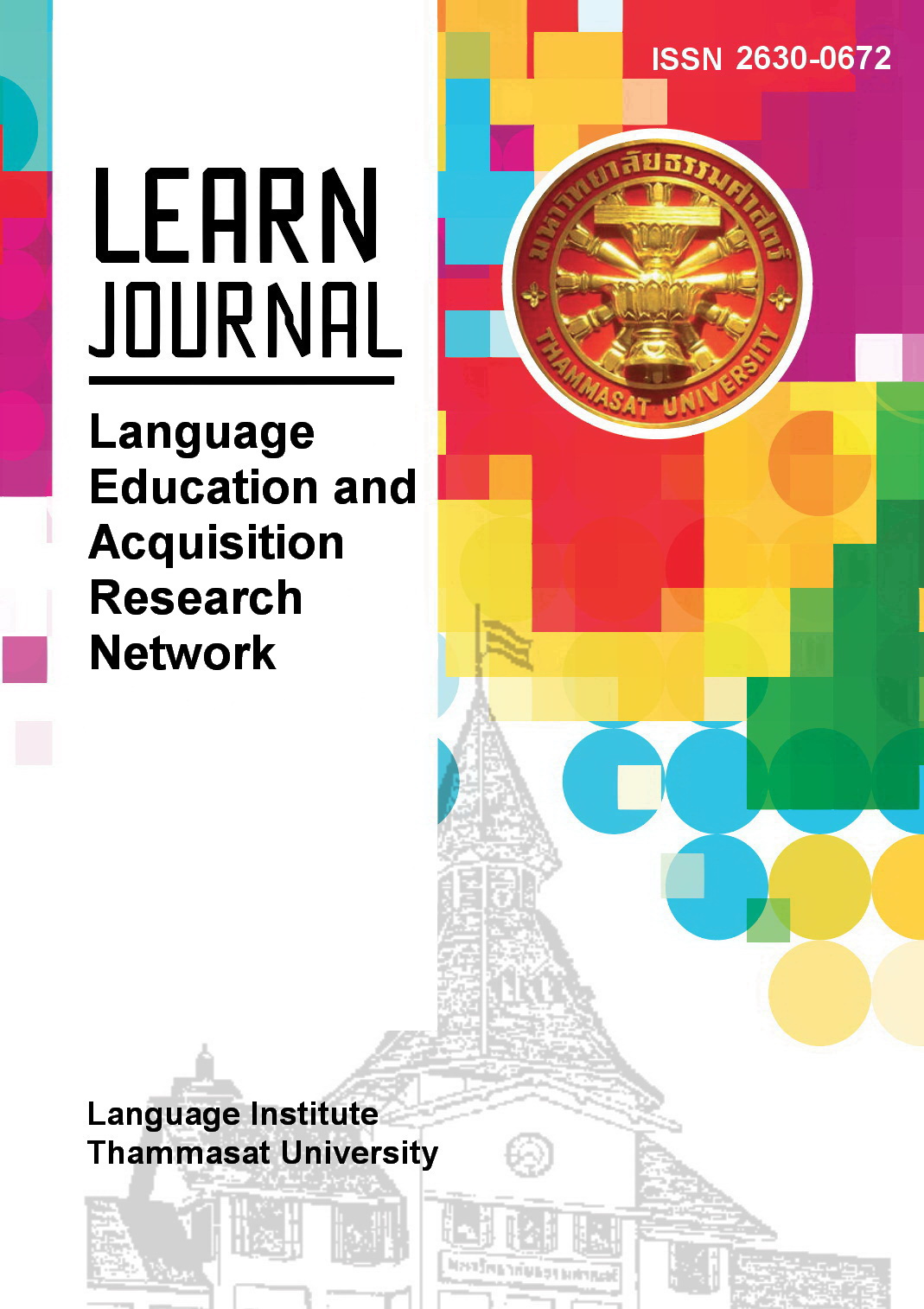Asymmetrical Sexual Scripts in Y Literature: Manifestations of a Heteronormative Discourse
Main Article Content
Abstract
Issues surrounding gender and sexuality are fundamental determinants of either a liberated or restricted human experience, and comprehensive sex education has been recognized as an essential mechanism to help youth process their gender and sexuality in a standardized, open, safe, and healthy atmosphere. In the absence of such education, Y novels are a growing source of cultural resources in the social sphere of sexuality, especially among Thai girls and young women. The present study differentiated between and analyzed the sexual scripts engaged in by the two leading characters, the pra’ek and nai’ek, in scenes of erotic significance from nine such novels. The dialogue and narration from these scenes were analyzed descriptively, and clear patterns of asymmetry emerged. These patterns were discussed as manifestations of heteronormative discourses. Y novels, despite the same-sex relationships that define them, were found to re-produce heteronormative discourses around masculinity and femininity. While Y novels may be an avenue for girls and women to explore their own sexuality in the heteronormative context in which they find themselves, the genre may also endanger girls, women, and queer-identifying people by re-producing meaning making that defines a ‘gray area’ of consent in sexual encounters.
Article Details
References
Archavanitkul, K. (2011). Sexuality transition in Thai society. Prachakon lae sangkom [Population and Society], 43-66. http://www2.ipsr.mahidol.ac.th/ConferenceVII/Download/2011-Article-03.pdf
Beres, M. A. (2013). Points of convergence: Introducing sexual scripting theory to discourse approaches to the study of sexuality. Sexuality & Culture, 17(1), 76-88. DOI 10.1007/s12119-013-9176-3
Boonmongkon, P. & Jackson, P.A. (Eds.) (2012). Thai sex talk: The language of sex and sexuality in Thailand. (T. Ojanen, Trans.). Mekong Press.
Chawalitthada, P. (2018). Sexual violence in Thai soap opera: A case of Sawan Bieng (Twisted Heaven). [Doctoral dissertation, Bangkok University]. http://dspace.bu.ac.th/jspui/handle/123456789/3807
Doungmanee, P., Lerlertyuttitham, P., & Prasannam, N. (2021). The representation of homosexual men in the Yaoi novel: My Accidental Love is You. Warasan manutsat lae sangkomsat mahawithayalai mahasarakham [Journal of Humanities and Social Sciences, Mahasarakham University], 40(4), 70-82.
Engchuan, R. N. (2017). Gender roles and female sexuality in the Thai teen TV drama Hormones, The Series. Rian Thai: International Journal of Thai Studies, 10(2), 101-120.
Farmer, B. (2011). Loves of Siam: Contemporary Thai cinema and vernacular queerness. In P.A. Jackson (Ed.), Queer Bangkok: 21st century markets, media, and rights (pp. 81-98). Hong Kong University Press.
Foucault, M. (1972). The archaeology of knowledge and the discourse on language. (A. M. Sheridan Smith, Trans.). Pantheon Books.
Jackson, S. (2006). Gender, sexuality and heterosexuality: The complexity (and limits) of heteronormativity. Feminist Theory, 7(1), 105-121. DOI: 10.1177/146700106061462
Jackson, S. & Scott, S. (2007). Faking like a woman? Towards an interpretive theorization of sexual pleasure. Body & Society, 13(2), 95-116. DOI: 10.1177/1357034X07077777
Jiararattanakul, Y. (2007). YAOI: Manga by women for women (4789173420) [Master’s thesis, Chulalongkorn University]. https://www.academia.edu/32682382/
Kaewthep, K. (2002). Khwamriang duai satri lae wathanathamseuksa [Women’s compositions and cultural studies]. Chulalongkorn University.
Khopolklang, N., Polnigongit, W., & Chamnongsri, N. (2014). Influence of the Thai mass media on violence against women: Synthesis of research studies. Kasetsart Journal – Social Sciences, 35, 167-176.
Kitzinger, C. (2005). ‘Speaking as a heterosexual’: (How) does sexuality
matter for talk-in-interaction? Research on Language and Social
Interaction, 38(3), 221-265. DOI: 10.1207/s15327973rlsi3803_2
McLelland, M. (2001). Why are Japanese girls’ comics full of boys bonking? Intensities: The Journal of Cult Media, 1. https://intensitiescultmedia.com/2014/08/27/japanese-girls-comics/
Neville, L. (2015). Male gays in the female gaze: Women who watch
m/m pornography. Porn Studies, 2:2-3, 192-207, DOI: 10.1080/23268743.2015.1052937
Piayura, O. (2010). Strength, dominance and sexualities: The presentation of masculinities in Thai erotic literature. Humanities and Social Sciences, 27(3), 34-39.
Piayura, O. (2018). Wanakam kap phetphawa [Literature and Gender]. Khon Kaen University Press.
Prasannam, N. (2019). The Yaoi phenomenon in Thailand and fan/industry interaction. Plaridel, 16(2), 63-89. https://www.plarideljournal.org/article/the-yaoi-phenomenon-in-thailand-and-fan-industry-interaction/
Sae-Kuay, P. (2001). Sathana satriseuksa: Chatniyom nai satriseuksa Thai raingan khwamlomleo nai kanthopthuan ekasan satriseuksa phasa Thai rawang pho. so. 2522-2542 [The Status of Women’s Studies: Nationalism in Thai Women’s Studies, A Report of Failures from a Review of Thai Language Women’s Studies Literature from 1979-1999]. Faculty of Social Sciences, Chiang Mai University.
Sakulak, J. K, Todd, L. M., Milhausen, & R., Lachowsky, N. J. (2014). Dominant heterosexual sexual scripts in emerging adulthood: Conceptualization and measurement. The Journal of Sex Research, 51(5), 516-531. https://doi.org/10.1080/00224499.2012.745473
Simon, W. & Gagnon, J. H. (1986). Sexual scripts: Permanence and change. Archives of Sexual Behavior, 15(2), 97-120. https://doi.org/10.1007/BF01542219
Sutheepattarakool, K. (2020). Construction of gay characters in Thai boy love series (3842294939) [Master’s thesis, National Institute of Development Administration]. https://repository.nida.ac.th/handle/662723737/5148
Svasti, P. (2009, January 22). Sex through the ages. Bangkok Post. http://www.bangkokpost.com/leisure/leisurescoop/10200/sex-through-the-ages
World Health Organization. (2022). Sexuality. In Defining Sexual Health. https://www.who.int/teams/sexual-and-reproductive-health-and-research/key-areas-of-work/sexual-health/defining-sexual-health


